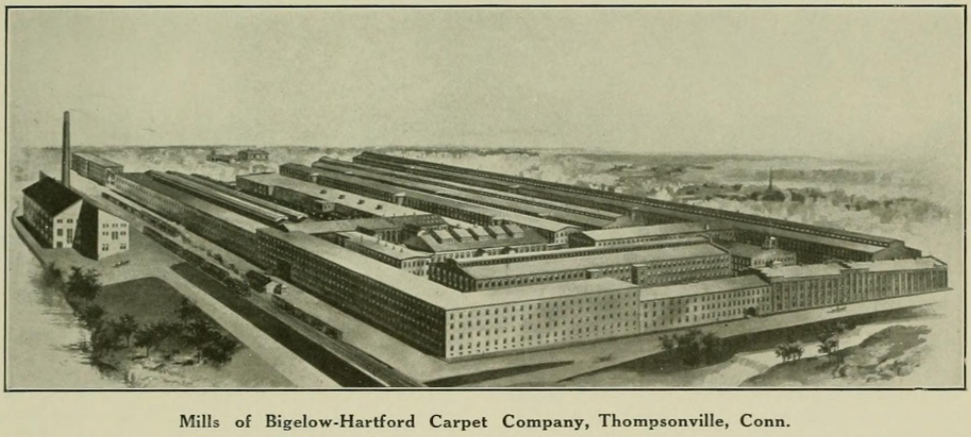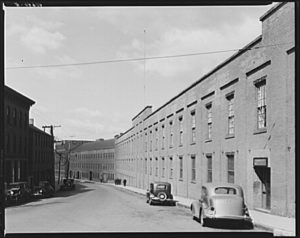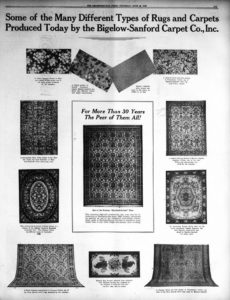By Edward T. Howe
In the 1820s, the first Connecticut carpetmakers emerged in the north central part of the state—the Tariff Manufacturing Company in Simsbury and the Thompsonville Carpet Manufacturing Company in Enfield. At its peak, Connecticut’s carpet industry included other small firms and had expanded to produce millions of carpets every year. Nevertheless, by the early 1970s the Connecticut carpet industry had ceased to exist.
Origins of Carpetmaking
Historically, carpets made from wool or goat hair can be traced back in antiquity to the Middle East. European carpet weaving did not become noticeable until the 10th century in Spain and appeared much later in the 17th and 18th centuries in England and France.
William R. Sprague opened the Philadelphia Carpet Company—the first woven carpet company in the United States—in 1791. Peter and Ebenezer Stowell followed with their cotton and carpet business in Worcester, Massachusetts around 1794. Early carpet factories—firms employing large numbers of wage earners—then slowly began to emerge between 1815 and 1824 in Maryland, New Jersey, New York, and Rhode Island.
Connecticut’s First Carpet Companies
In 1825, the Connecticut General Assembly incorporated the Tariff Manufacturing Company—the first carpet factory in the state. A year earlier, Congress passed the Tariff Act of 1824 which imposed a rate of 30 percent on raw wool and 33 1/3 percent on woolen goods to protect domestic textile firms from British competitors. Given this incentive to meet foreign competition, Connecticut investors decided to establish a carpet mill in what became known as the village of Tariffville in Simsbury. Tariffville, located about twelve miles from Hartford on the Farmington River, was a mill community with buildings and housing for its workers, including Scottish weavers.
The Tariffville mill focused on producing ingrain carpets. Two-ply reversible ingrain carpets were simple to make using coarse raw wool from South America and the Middle East. When produced, the company profitably sold them to New York wholesale dealers. As a result, total employment at the mill grew quickly; by 1832, the factory employed 136 men, women, and boys. After the Panic of 1837, the new owners of the business (now named the New England Carpet Company) realized they could not afford much-needed power looms and sold the firm in 1840 to Orrin Thompson. He renamed it the Tariffville Manufacturing Company.
Thompson previously founded the Thompsonville Carpet Manufacturing Company in 1828 in Enfield—the second carpet factory in Connecticut. Like Tariffville, Thompsonville was a mill community that employed Scottish weavers to make ingrain carpets with coarse grain wool obtained from abroad and used water-powered carding and spinning machines. It expanded rapidly—employing 157 workers in 1832—and sold its output to the company-owned wholesale dealership in New York City. By 1847, Thompson had installed power looms in both the Thompsonville and Tariffville carpet mills to greatly expand production. Although ingrain carpets dominated production,Thompson also made some luxurious patterns such as Axminster carpets. By 1850, Thompson’s company produced 250,000 yards of carpet annually with 1,650 employees. Unfortunately, Thompson went bankrupt in 1852, but new owners saved the company in 1854 and renamed it the Hartford Carpet Company. Although no longer the owner, Thompson continued to run the company until 1861. Six years later, a fire destroyed the Tariffville complex.
Mergers and Demise of the Carpet Industry
The Thompsonville mill prospered over the ensuing decades. It merged with the E. S. Higgins Company in 1901, creating the Hartford Carpet Corporation. A consequent expansion of its facilities led to 2,900 employees producing 7.5 million carpets per year by 1910. Another merger (in 1914) with the Bigelow Carpet Company of Clinton and Lowell, Massachusetts created the Bigelow-Hartford Carpet Company—the third largest corporation in New England with its three complexes. A third merger with Stephen Sanford and Sons of Amsterdam, New York gave rise to the Bigelow-Sanford Carpet Company in 1929. It became the largest carpetmaker in the country, with its biggest factory in Thompsonville. Various other smaller companies produced carpets in Connecticut (since at least 1830) and around the rest of New England, but after 1914, only the Thompsonville mill remained. It finally closed in 1971.
Edward T. Howe, Ph.D., is Professor of Economics, Emeritus, at Siena College near Albany, N.Y.











